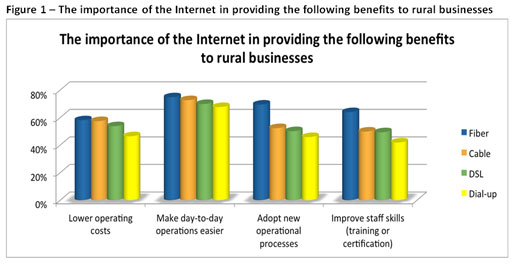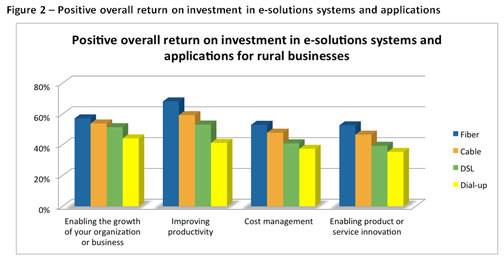by Doug Adams
If you haven’t moved for a job, you know someone who has. More than a decade into our broadband revolution, the knowledge economy, and e-everything, it’s a bit discouraging to find that, even today, geography can still dictate individual or organizational potential for success. Still, in 2011, the digital divide limits job and opportunities, either at an organizational or an individual/entrepreneurial level, in rural areas.
Of course the digital divide is nothing new – but lately it seems that the class warfare in the haves and have-nots has shifted from an economic divide to a geographic one. With major investments being made across the globe to increase capacity and deliver  broadband to the under and un-served (most notably with investments in Australia and the United States), there are still some that would have you believe that investing in broadband just isn’t worth it for some.
broadband to the under and un-served (most notably with investments in Australia and the United States), there are still some that would have you believe that investing in broadband just isn’t worth it for some.
The idealist in me immediately wants to refute this as ridiculous, short-sighted thinking! How could anyone not know the benefits of broadband including the economic and social benefits that accompany more robust Internet connectivity? Don’t these people realize that to survive and thrive in the knowledge economy, broadband is the key enabler? Haven’t they seen the “build it and they will come” movie where people flock to Iowa in ‘Field of Dreams?’ Hasn’t the availability of broadband and the rise of every broadband enabled device taught us anything about the potential of broadband? Are these people naïve? It may even be a legal requirement as soon the only way my grandmother can access services will be online… does she need to move?
Then I take a step back from my knee-jerk reaction and let the pragmatist in me take over. As a broadband economist, I along with my firm, SNG, dissect where the demand for broadband exists – and where investment will have the deepest, most long-lasting impacts. We do this through a step-by-step methodology that includes direct stakeholder feedback.
Needs vary. It is nice to aspire to ultra-fast, fiber to the home for everyone… but is that practical? Ideally, we would see a world where everyone could innovate with no barriers. Pragmatically, many would just watch higher definition online feeds of Sponge Bob.
Do businesses need ultra-speed Internet? I would argue they will eventually, whether they realize it or not. But pragmatically, we need to – at the very least – get anchor institutions equipped with middle and last mile access so for today’s needs as well as tomorrow’s, communities are better equipped to expand into the world of fiber and ultra-speed broadband. Schools and hospitals MUST have ultra-broadband to prepare students for life… and to save lives with telemedicine.
It is inevitable that the combination of computing power and demand for new and better applications and new approaches such as cloud computing will increase the need for more speed by the majority of users over time – no matter whether they are in New York, NY or in a cornfield in Iowa.
For the Statisticians… Productivity by the numbers
SNG’s research shows that organizations are more efficient the greater the Internet speed they have available to them. Speed matters, regardless of how it is delivered. Move to the greatest access available, ideally fiber. Friends don’t let friends use “basic broadband.”
- For Fiber users the positive ROI on e-solutions for improving productivity is 8.9% higher than Cable and 14.2% higher than DSL.
- For Fiber users the importance of broadband for adopting new operational processes is 8.1% higher than Cable and 10.3% higher than DSL.
- For Fiber users the importance of broadband for improving staff skills is 14.3% higher than Cable and 14.8% higher than DSL.


With all of the hub-bub around broadband build out, it is important not to forget about utilization… and how you drive meaningful utilization in your community.
A great compliment to our recently announced Market Demand Snapshot is an Action Plan for Broadband Utilization. Designed to spur economic development and job creation, and incorporating feedback from stakeholder workshops, SNG can provide you with will provide the tactics, methods and tools needed to drive broadband adoption and meaningful use.
As we continuously preach, broadband availability alone is not enough to realize its social and economic benefits. An understanding of how to effectively use of broadband for commerce, citizen services and the positioning of rural counties as attractive areas for 21st century business and living will play a critical factor in their long-term success of your broadband investment and your ability to impact the lives of the citizens and businesses already located in the regions.
 SNG can help your region with effective strategic planning for impactful economic development with a sound, three-step approach:
SNG can help your region with effective strategic planning for impactful economic development with a sound, three-step approach:
- Identifying and rallying the key stakeholders that need to be actively engaged in the economic development through broadband adoption process via the application of broadband best practices;
- Laying the foundations for an actionable strategic plan that will enhance broadband adoption, meaningful use and job creation across identified verticals of interest, e.g. residences, schools, businesses, libraries, healthcare facilities, public safety and government;
- Driving efficiencies into the community through the adoption of digital purposes and broadband enabled applications that increase quality of life, the growth of economic and employment opportunities, and spurring commercial investment locally.
If you are interested in learning more about how this structured approach can drive demand, adoption and meaningful use to advance your region’s ability to compete globally, attract investment, realize efficiencies, and create jobs, contact Michael Curri.

Charles Berry
Our friend and colleague Charles Berry passed away at this past Friday. He was 42 – much too young. We loved him dearly.
His life was filled with adventure and achievement, love and laughter. Charles spent every waking hour living life to its fullest – and his ambition and love of life often drove him to sleep deprivation. During his time with us, Charles crammed as much life into every day as anyone you could ever meet..
Charles used to say with pride that he and his family could pack and be on their way to their next adventure in a few hours. He and his childhood best friend and wife Dawn saw so much of this world as work and thirst for cultural diversity and life experiences saw them set down not only coast-to-coast in the United States, but in Japan, India, and France. He dearly loved the Cannes in the French Riviera and the Georgia Coast and wanted us all to experience them with him. Other than his childhood home of St. Louis, the past 4 years in Cleveland were the longest Charles and Dawn had stayed in one place. “Too much to see and do,” Charles used to say with his infectious smile.
Charles was a brilliant man, evidenced by his numerous career achievements, which culminated in the formation of his own venture with a small group of partners – a broadband consulting firm named Gigabit Squared, which now serves clients all over the globe. It is ironic and sad that Charles’ untimely death came at a point in his life when he was going to get “back to seeing the world” and travelling. The past few months Charles was happier than ever – ready to take on and conquer challenges all over the globe as the company he had help build was ready to take off.
But Charles’ brilliance was most evident when he shared a dinner with a friend – and discussed politics, religion, business, or even the intricacies of the NBA, NFL, or Soccer. Charles was quite competitive and loved a challenge – so he was drawn to friends and colleagues who he could banter back and forth with for hours. Always good natured, always with a laugh and an excited smile, Charles would – as many of his friends called it – ‘hold us hostage,’ saying ‘just five more minutes’ so that we could continue the debate, discussion, and laughs. Time with Charles was always challenging and exhilarating – he was going to push you and laugh with you and make sure that he challenged any of your preconceived beliefs. He loved playing the Devil’s Advocate because he could argue either side of a position brilliantly, and he loved to challenge the minds of the people he cared about.
While Charles was fiercely proud of his nomadic, go anywhere lifestyle with no geographic roots – the roots he did put down were with the people in his life. Fiercely loyal, if Charles counted you a friend, you were a friend for life, no matter the distance. He spent so much time with the people in his life every day that often his workday ended up being 8 p.m. to 5 a.m.
He leaves behind his wife, childhood best friend Dawn, and daughter Magda, 11, and son Nigel, 9. While our relationship with Charles was mostly away from his family, there was no doubt to any of us that they were always close to him. And when we saw Charles with his wife and children, his smile grew even bigger and the twinkle in his eye was less mischievous nature and much more reflecting pure love and admiration for the family that he adored. His children will always know that Daddy loved them more than anything in this world.
We are all still in shock with the untimely passing of our dear friend. Not a day will go by without some reflection, a memory of laughter with this big hearted man. We will miss him dearly, but know what he would tell us. That it is our job to pick up and keep going. To let his life serve as a reminder to pack every bit of life, love, and laugher into every day. There was really no one else like Charles. As his friends, it will be our charter to honor him by challenging our minds, taking time for friends and family, and remember, as he used to tell us, “not take all of this so seriously.”
Economuse, 8 July 2011, by John de Ridder

The benefits of broadband are derived from how it is used; not just having access. While the supply plan is well-developed, there is no execution plan yet to ensure that faster broadband is fully exploited and that without an action plan that engages end-users directly, the expected benefits of broadband will not be realised.
At last, the focus on the NBN is shifting from supply -“When and what will we get?”- to demand -“How will we use it?”. The benefits of broadband are derived from how it is used; not just having access. While the supply plan is well-developed, there is no execution plan yet to ensure that faster broadband is fully exploited. Without an action plan that engages end-users directly, the expected benefits of broadband will not be realised.
Let’s take telework as an example. It is an obvious application for fast broadband and we have known about that for a long time. To his credit, Senator Conroy has set some quantitative targets to be reached by 2020 for the eight goals of the National Digital Economy Strategy. In the case of telework, the goal is to “double the level of teleworking so that at least 12% of Australian employees may work away from the traditional workplace”. That implies it is about 6% now – right?
Wrong. The latest figure we have is indeed 6% but it comes from an ABS Time Use Survey conducted in 2006 – the figure is 5 years old! Worse, the next survey will not be conducted until 2013 with results not available until 2014. The hard 12% target may not be so hard to get – I suspect that with the changes in broadband availability over the last 5 years, we may already be at 12%.
My point is that if you cannot measure it, you cannot manage it. We have a strategy and goals but no framework for execution that provides better information on where we currently are. Furthermore, we do not have actionable intelligence on barriers to adoption and gaps that will need to be addressed.
It is not difficult to fix; although I should declare an interest in the proposed solution.
The Government’s 12% target for telework may have been inspired by the reference in the NDES document to 11% of US employees teleworking at least 1 day a month. That must be an old figure. Last year, the Strategic Networks Group (SNG) found that 18.9% on average (25.6% in metro areas) teleworked in North Carolina; with about half of these reporting that they telework more than 3 days a week!
What we need is e-solutions benchmarking data gathered directly from organisations and households that not only provides more current data of progress towards NDES goals, but also maps drivers and barriers to utilisation and captures the benefits. In the case of telework, for example, comparisons for the same type of organisation across different regions would point to where non-users could usefully be educated about the benefits. The framework that SNG uses also allows individual respondents to compare themselves with their peers.
Case studies like those to be presented at the DBCDE-AIIA teleworking forum on the 3rd of August are fine. But there is no reason to expect that preaching the virtues will be any more successful than it has been to-date. We need an execution framework that engages end-users directly, which in itself promotes awareness and drives utilisation of broadband-enabled solutions.
John de Ridder represents the Strategic Networks Group (SNG; www.sngroup.com ) in Australia.
Note: The 6% figure is used in the ABS Household Use of Information Technology, Australia, 2007-08, Cat No 8146.0, 18 December 2008
 broadband to the under and un-served (most notably with investments in Australia and the United States), there are still some that would have you believe that investing in broadband just isn’t worth it for some.
broadband to the under and un-served (most notably with investments in Australia and the United States), there are still some that would have you believe that investing in broadband just isn’t worth it for some.







